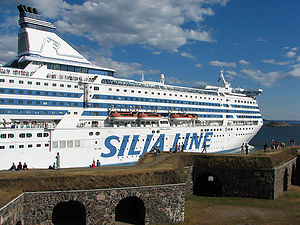Baltic Sea cruiseferries

The Baltic Sea is crossed by several cruiseferry lines. Some important shipping companies are Viking Line, Silja Line and Tallink.
Eastern Baltic
Tallink and Viking operate competing cruiseferries on the routes Stockholm - Turku and Stockholm - Helsinki, calling in Åland (Mariehamn or Långnäs). They also compete in sailings between Helsinki and Tallinn.
Additionally Tallink sails Stockholm - Åland - Tallinn and Stockholm - Riga while Viking sails Åland - Kapellskär).
The busiest cruiseferry route in the Baltic is the 80-kilometre (50-mile) voyage between Helsinki and Tallinn, travelled by over 6 million people in 2008.[1]
Baltic routes are mostly trafficked by new ships purpose-built for the routes. Older cruiseferries from the Baltic serve as ferries on other seas, or in some cases, as cruise ships
Generally GTS Finnjet of 1977 is considered to have been the first cruiseferry, she was the first ferry to offer cruise-ship quality services and accommodations, and the first generation of cruiseferries operating from Finland to Sweden were highly influenced by Finnjet's interior and exterior designs. After the fall of the Soviet Union the route connecting Helsinki to Tallinn became highly lucrative, which led to Estonia-based company Tallink to grow and rival the two long-established companies (Viking Line and Silja Line). Eventually Tallink purchased Silja Line in 2006.
The size of Baltic cruiseferries is limited by various narrow passages in the Stockholm, Ålandian and Turku archipelagos, meaning ships not much in excess of 200 meters cannot traffic on these routes. The single narrowest point is Kustaanmiekka strait outside Helsinki, although ships making port at the city's west harbour do not have to pass through the strait. Viking and Silja Line have wished to keep their terminals in the South Harbour however as it is located right next to the city center. The largest ships to maintain scheduled service through the Kustaanmiekka strait were MS Finnstar and her sisters with a length of 219 meters. The largest ship to have ever navigated though the narrows past Suomenlinna sea fortress was MS Oriana (260 m), but that was only possible due to extremely good weather conditions.
Tax-free sales
The expansion of the European Union has limited the growth of the industry as duty-free sales on intra-EU routes are no longer possible. However, as the Åland Islands are outside the EU customs zone, duty free sales are still possible on routes making a stop at Mariehamn or other harbours on the islands. Another popular destination is Estonia with its lower taxes on alcohol.
The ferries have been criticized because of the low prices of alcoholic beverages which encourage passengers to become drunk and act irresponsibly. Due to the relatively cheap price of the cruises and availability of duty-free alcohol (which makes it considerably cheaper than on "land" as both Finland and Sweden have a relatively strict taxation of alcohol) many big parties involving vast amounts of alcohol consumption are held on the ships.[2]
Accidents
- September 28, 1994, MS Estonia sunk claiming 852 lives.
- January 9, 2009, MS Rosella had to anchor just outside Mariehamn, Åland due to water in its fuel. When rising the anchor she hooked the cables of internet traffic to Åland.[3]
- August 29, 2009, a fire was extinguished on MS Finnfellow, carrying 74 passengers at the time.[4]
References
- ↑ [1], The busiest crossing.
- ↑ Silja Line: Special Cruises (Swedish)
- ↑ Fakta om fartyg: M/S Rosella (Swedish)
- ↑ DN: Brand på färja utanför Åland (Swedish)
